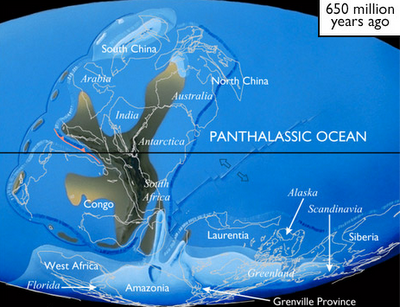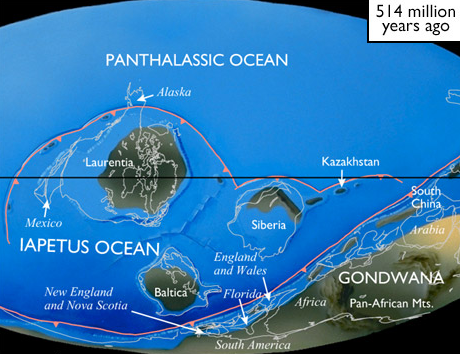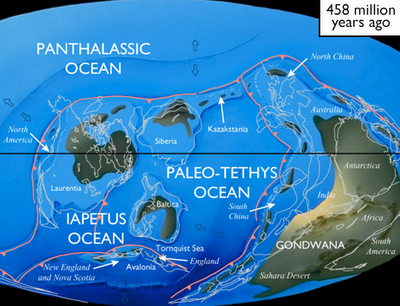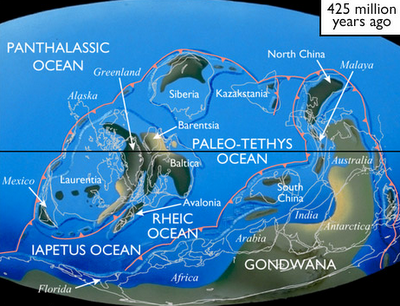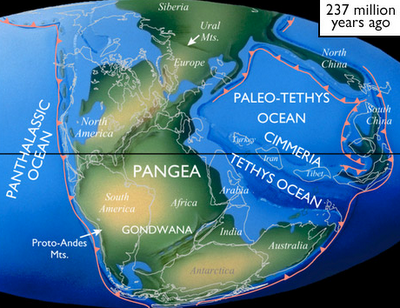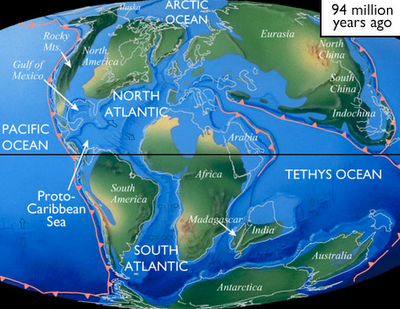 | Reconstractions |
ANCIENT RODINIA RIFTS APART SPAWNING LAURENTIA AND GONDWANA. Map from Scotese.com |
AVALONIA RIFTS FROM GONDWANA. Rodinia has rifted into the two major landmasses. The Iapetus Ocean separates equatorially-located Laurentia from australly-located Gondwana. In the Middle Cambrian, the juvenile, island-arc terrane of Avalonia (shown as "New England and Nova Scotia" on the map) rifted from the northern margin of Gondwana. Thus began a tectonic journey that would transport Avalonia across the Iapetus Ocean and culminate with its collision with Laurentia. Located within the terrane of Avalonia, the foundation on which the city of Boston was built formed from Neoproterozoic rocks that originated in the mid- to high-latitudes region of the Southern Hemisphere. Map from scotese.com. |
This South Polar perspective during the Early Ordovician, Avalonia (labelled as such) is beginning to rift from Gondwana and will then initiate a trajectory across the Iapetus Ocean, along with Baltica, towards Laurentia. Equatorially-located Laurentia (far left) awaits their collision. From Cocks and Torsvik 2006 |
AVALONIA BEGINS A TECTONIC JOURNEY ACROSS THE IAPETUS.During the Late Ordovician, Avalonia rifted from Gondwana, which is stretched from the South Pole to north of the equator (seen off to the right). Along with Baltica (which formed Scandinavia and parts of Europe), the two landmasses drifted towards Laurentia, as the Iapetus Ocean closed. The rifting of Avalonia from Gondwana occurred diachronously with the formation of the intervening Rheic Ocean, which will ultimately close during the formation of Pangaea. The basement rocks of the Boston Bay Group, including the Roxbury Conglomerate, have already formed on Avalonia, and are now tectonically traveling with it. At about the Ordovician-Silurian boundary while drifting in the Iapetus towards Laurentia, Avalonia amalgamated (a soft, oblique docking) with Baltica in equatorial paleolatitudes. That amalgamation consumed the intervening Tornquist Sea (see map). Map from scotese.com |
AVALONIA AND BALTICA ZERO-IN ON LAURENTIA. During the Middle Silurian, Avalonia and Baltica are about to collide with Laurentia. Laurentia will become Laurussia. The Iapetus Ocean is nearly consumed at the expense of the opening Rheic Ocean. Gondwana is growing near. It too will collide with Laurussia. After the consumption of the Iapetus Ocean with the collision of Avalonia and Baltica to Laurentia, a new ocean will form called the Atlantic with the rifting apart of Pangaea. In Greek mythology Iapetus was the father of Atlas. Map from scotese.com |
GONDWANAS LAURUSSIAN COLLISION FORMS PANGAEA .During the Late Triassic, with Gondwana having slammed into Laurussia, Avalonia has become internalized within Pangaea. The collision has initiated the Alleghenian-Hercynian/Variscan Orogeny, a major mountain-building event. Early rifting of Pangaea is initiating in the north. Note that both the Iapetus and Rheic Oceans have long been consumed, leaving the Panthalassic Ocean as the major global body of water. The rifting of Pangaea began in the north during the Early to Middle Jurassic with the formation of the North Atlantic Ocean. Map from scotese.com |
RIFTED PANGAEA.In the Late Cretaceous, Pangaea has rifted apart and the contemporary continents of the world have dispersed throughout the globe. Previously-accreted Avalonia, now referred to as the Southeastern New England Avalon Zone, which includes the Boston Basin, has assumed a passive location on the coast of eastern North America. The majority of the eastern seaboard of present day North America was derived from similar but smaller peri-Gondwanan terranes (e.g. Ganderia, Carolinia, Meguma), some from an African and others from an Amazonian locale. A corollary to the break up of Pangaea was the redistribution of early Paleozoic parts of Laurentia and Avalonia (giving rise to the terminology of West and East Avalonia) on either side of the North Atlantic, where we find them today. Therefore, in addition to New England and Atlantic Canada, Avalonia formed parts of southeastern Ireland, southern Britain, and a substantial area of Europe surrounding Belgium, after Pangaea rifted apart. From scotese.com. |
During the late Precambrian (Neoproterozoic ca. 1100 Ma), a massive supercontinent commonly referred to as Rodinia formed and broke up (ca. 800-700 Ma). The timing of break-up and the exact fit of its elements remain somewhat controversial. Regardless, Rodinias rifting apart eventually spawned two smaller supercontinental siblings called Laurentia and Gondwana (also Gondwanaland). Gondwana included most of the continental landmasses in todays Southern Hemisphere. Proto-Avalonia (during the Proterozoic) has been suggested to possibly have a peri-Rodinian, island-arc provenance in spite of the fact that undisputed basement upon which it developed is nowhere, unequivocally exposed (with the exception of one peri-Gondwanan terrane called Tregor-La Hague in northern France dated ~2 Ga). Regardless, the origin of the proto-Avalonian terrane remains controversial.
